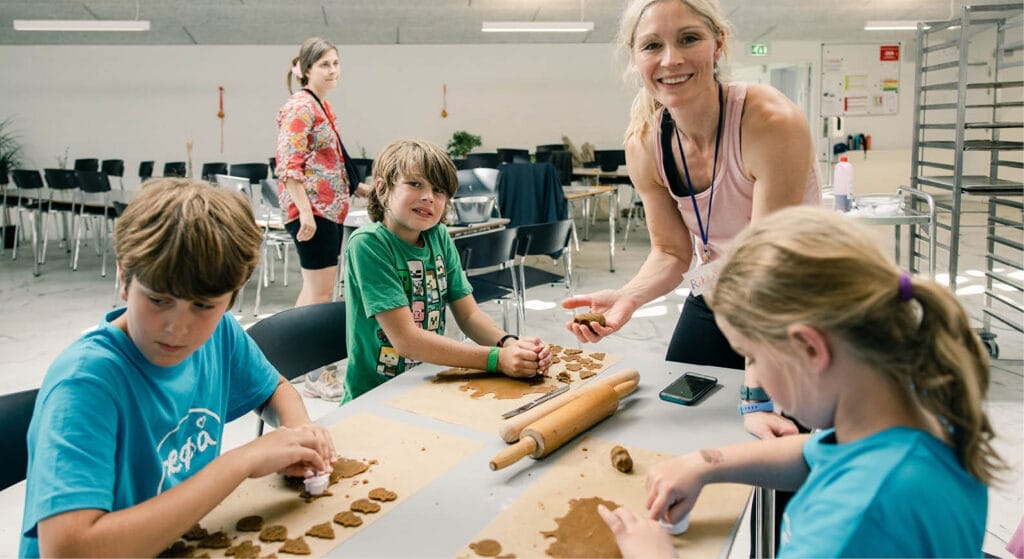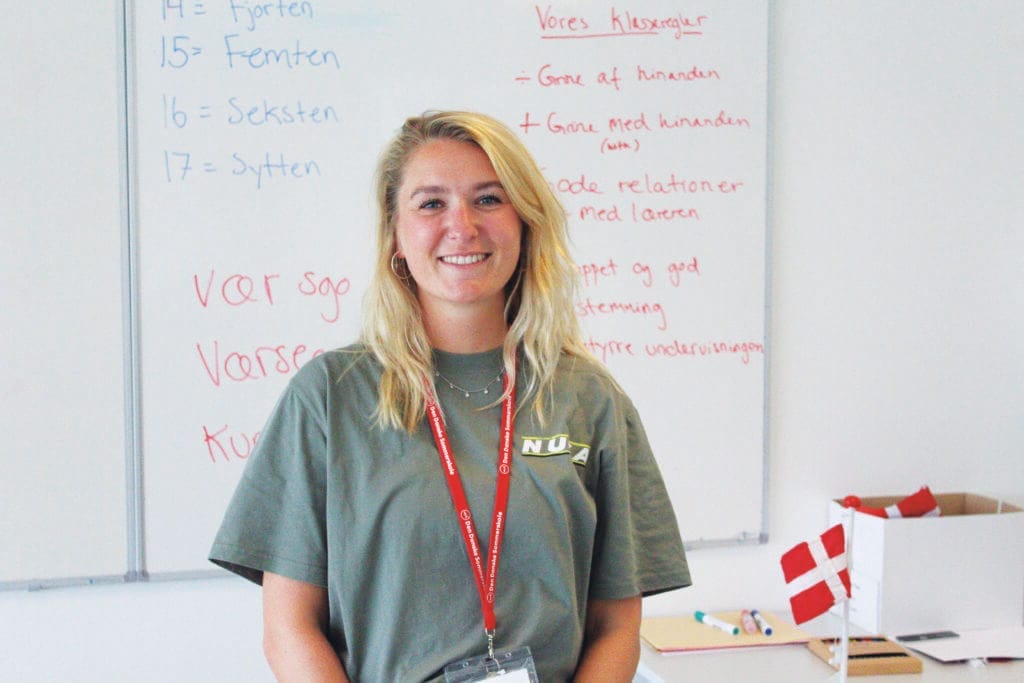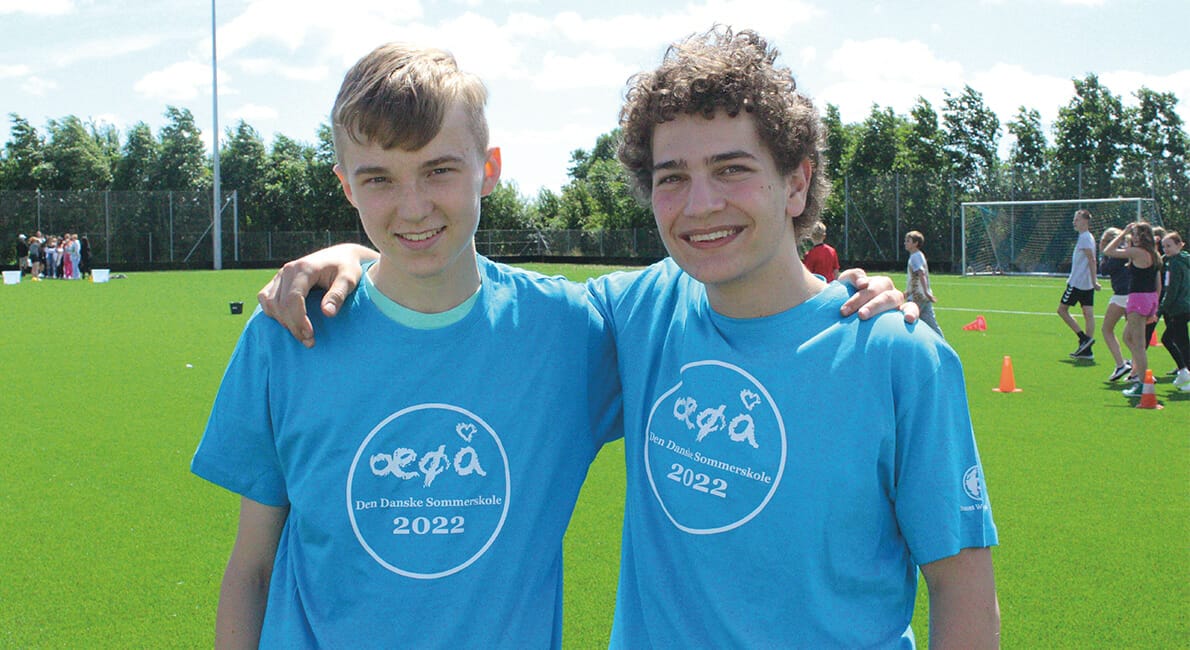WRITTEN BY: MARIE VARMING, FREELANCE JOURNALIST
On a football field in South Funen, around 190 young people are running around in sports attire, getting to know each other in a community setting. It’s one of the first days at The Summer School 2022, and the language among many students is still predominantly English, even though everyone is here to learn more about Denmark and, of course, to improve their Danish. Not everyone has mastered the language yet. But the desire to get to know the others and the opportunities to learn and strengthen their Danish are plentiful.
“I make new friends that I see every summer.”
Two of the students have taken the time to speak with the magazine DANES about why they are there. Zakary is 17 years old and lives in Paris with his parents on a daily basis. He is one-quarter Danish – ‘on paper’.
“My sister still sees the friends she made at The Summer School when she attended.
“My brother was at the summer school a couple of years ago, and he said so many good things about it. He met many wonderful people and had fun. That’s why I tried it myself a couple of times, and now I look forward to every summer where I’m going to learn to be Danish,” Zakary de Ribier Mazouni smiles.
His story is somewhat similar to George Christiansen’s. He is 15 years old and comes from West London, and just like Zakary, he is for now most comfortable speaking English, even though he is here to learn Danish.
“My dad attended here himself when he was my age, and my older sister is also here and has told me about all the wonderful things she experiences at The Summer School. That’s why I came here for the first time last year.”

“And then I make new friends that I see for three weeks every summer. My sister still sees the friends she made at The Summer School when she attended,” says George, while Zakary nods.
He also has a thought on what makes the summer school special.
“We are all very different and come from all over the world, but we also all have one thing that binds us together – a link – and that is that we are a bit Danish,” says George, who is three-quarters British and one-quarter Danish and has a British passport.
“It’s a difficult language, but the teachers make it easy.”
The boys note that despite coming from two different school systems, The Danish Summer School stands out because here, learning occurs alongside fun.
“In London, we wear uniforms, and you don’t talk that much with your teachers. The classes in London are also much larger than here, and the teachers are different too. They are young and energetic and more similar to us in age than the teachers I know from home.”
Zakary nods.
“Here, we also have a say in what happens in the classes. In Paris, it’s more about rote learning and writing, and you usually sit in the classroom from 8 am to 5 pm every day, whereas here, we go on trips and play games in the afternoon.”
There’s no doubt that being at The Summer School is both fun and educational.
“When I came here last year, I knew nothing about Danish, but when I returned to London, I could have ‘basic conversation’. So now, I also speak a little Danish at home with my dad, and he teaches me new words,” says George.
Zakary is familiar with this too, as he gradually speaks a bit of Danish with his mother at home in Paris, and he would like to continue doing so.
“You kind of forget the Danish during the year, but the summer after, you become even better than you were before,” George explains.

The world’s best summer with Danish language and culture
Language school, Danish culture classes, fun and creative activities – and the place where lifelong friendships begin.
Join our summer schools for children and young people aged 10-17 or the Family Summer School for parents and grandparents with children aged 6-13.
It’s not just grammar and vocabulary that the boys get to practice. It’s also Danish culture, right down to the detail.
“Yes, for example, we get Danish snacks. What’s it called again, that sour milk with biscuits,” George asks, desperately searching his vocabulary for the words “koldskål med kammerjunkere.”
“Yes, and rye bread with toppings and Faxe Kondi,” Zakary adds. Besides, they sing a lot of Danish songs.
“This morning we sang ‘Jutlandia’ and our favorite, which we stand and sing with arms around each other: ‘People like us do need a girlfriend’ by Kim Larsen,” Zakary says. He blushes slightly when he hears that it’s actually Poul Krebs who is the original artist of the old song.
However, the boys agree that the hardest part of Danish is the pronunciation. Even though it’s in their genes, and Zakary also speaks Arabic and French, the Danish language has sounds that one just needs to get used to producing.
“It’s a difficult language, but the teachers make it easy for us, and I constantly challenge myself to speak it,” says Zakary.
But they’re actually learning more than just speaking Danish. They’re learning how work is structured in Denmark, for example, in group work and relays, which is very different from what they’re used to in their home countries.
The uphill struggle
Of course, it is not without a large number of teachers when children and young people from all over the world attend the Summer School for 17 days. This year, there are a total of 64 teachers and activity leaders spread across the Summer School’s three departments to ensure that both the school day and leisure time are fun and safe for the 499 participants.
One of the teachers is Josephine Halle, who has worked as a teacher at an independent school but is currently studying educational psychology at the Danish University of Education. She spends much of her summer holidays teaching beginners’ Danish, which she loves.

“There is a very steep learning curve in this class,” she emphasises. The 12-13 students in her class already know only a few words of Danish, but they are highly motivated to learn it, so they go all out and work intensively with the language for almost three weeks.
“But they actually learn more than just how to speak Danish. They learn how we in Denmark structure our work in, for example, group work and relays, which is very different from what they are used to in their home countries.”
“Many of the students in my class have ambitions to study in Denmark one day, and there is a long way to go because the class is in beginner Danish – but it is the start of learning the language and the start of a network.
For example, many would also like to use Danish to build closer relationships with their Danish grandparents.”
“It gives me so much as a teacher to work with this unique target group. You don’t find it anywhere else. I can feel that the students want to move forward, and their questions about Danish challenge me as a teacher. Yesterday, for example, a student asked me why we sometimes answer “jo” instead of “ja” in Danish. I had to think about that, because no other students ask that question,” says Josephine Halle.
At the Summer School, there are regular trips out of the house, as the students get to experience Denmark. These include trips to Tivoli Gardens, farm visits and days at the beach. They also get to use what they learn in class.
“For example, we have played fish in class, where students have learnt to say “May I ask for all your nines”. The other day, a student proudly told me that he himself had asked for an ice cream in a shop.”
“This is how we learn the language. By asking each other what things are called, talking about food in the dining hall and playing games in Danish and so on.”
“It’s a fun mix of some very basic language that this group of teenagers have to learn, but they like quizzes, relays and oral presentations, and that makes it less ‘babyish’ for them to learn.”
Luckily, the Danish teaching culture encourages creativity, and Josephine’s students love it.
“They’re already good at IT, technology and music, so it’s easy to get them to make films and do voiceovers in Danish.”
For example, if we’re walking down the corridor and hear English, we say, “Hey, what language is that?”
Occasionally – especially in the beginning – English is the dominant language among the students at the Summer School, because the young people

“We adults always speak Danish and only translate the most important things into English. We also emphasise to them that they should speak as much Danish as possible at the Summer School. For example, if we are walking down the corridor and hear English, we say “Hey, what language is that?” But we also have to take into account that they are a large group of people from all over the world, and some of them don’t know much Danish already.”
Today, Josephine’s class has just worked on presenting themselves in Danish, and she hopes that the evening will be spent practising on each other.
A class for everyone
The summer school is divided according to the students’ starting point; the Back to Denmark class is for the oldest students who are about to move to Denmark and therefore visit dormitories and continuation schools and look at study programmes while honing the Danish they already know. Then there is a confirmation class with a priest who will be confirmed this summer.
I’m actually on my way to engineering school in Paris, but the Summer School has made me fall in love with Denmark.
There is also a class for students who will be taking their 9th grade final exams this summer, and finally there are the regular classes, which are again divided into three levels – not by age, but by language proficiency (Beginner Danish, Basic Danish and School Danish, ed.).
In the evenings, however, when students go back to their rooms, they live with others in their age group, as they are in mixed-age classes. The oldest students are at Bernstorffsminde Efterskole on South Funen, while the younger students stay at Balle Efterskole near Vejle.
The day follows a fairly fixed routine, starting with a shared breakfast in the dining hall. Then there are two modules of Danish lessons and lunch in the dining hall. After that, there are afternoon activities organised by the activity leaders. They also organise the daily
George and Zakary agree that they are not just at the Summer School for fun. There is a deeper meaning to learning Danish language and culture.
I don’t know what I want to do when I choose a study programme, but I like the idea that I’m keeping the doors open to Denmark.
“I want to learn Danish so that one day I can continue my studies here. Right now, the only thing stopping me from continuing my studies in Denmark is the language. I’m actually going to engineering school in Paris, but the Summer School has made me fall in love with Denmark, so maybe I’d actually rather study here one day.”
George agrees.
“I don’t know what I want to do when I choose a study programme, but I like the idea that I’m keeping the doors open to Denmark,” says George, who is currently looking forward to the big activity of the evening – the lagkage race (birthday cake race)



